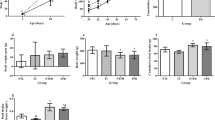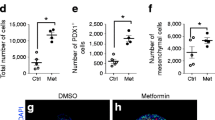Summary
The aim of this study was to investigate the effects of excess all-trans retinoic acid, a vitamin A metabolite, on pancreatic organogenesis and TGF-β2 expression during prenatal development in rats.
First group of animals used as control while a single dose of 60 mg/kg all-trans retinoic acid was ingested by the mothers, at day 8 of gestation (before the neurulation period) in group II and at day 12 of gestation (after the neurulation period) in group III, and all embryos were sacrificed at day 18 of gestation. TGF-β2 expression was detected in the capsule, acini and Langerhans islets in the control group. In the pancreas of group II, dilatation and congestion of interlobular vessels were observed. Langerhans islet structures were completely absent. Moreover acinar TGF-β2 immune reactivity was not determined. In group III, acinar expression of TGF-β2 in acid was similar to that in the controls but their Langerhans islets TGF-β2 immune reactivity was significantly less than the controls.
In view of the present findings we suggest that TGF-β2 plays important role in pancreatic morphogenesis and administration of excess all-trans retinoic acid before neurulation inhibit TGF-β2 expression disrupted pancreatic morphogenesis particularly Langerhans islets. However, its administration after neurulation had less adverse affect on pancreatic organogenesis and TGF-β2 immune reactivity.
Similar content being viewed by others
References
Bushan A, Itoh N, Kato S, Thiery JP, Czernichow P, Bellusci S, Scharfmann R (2001) Fgf10 is essential for maintaining the proliferative capacity of epithelial progenitor cells during early pancreatic organogenesis. Development 128(24):5109–5117
Cabrera-Valladeres G, German MS, Matschinsky FM, Wang J, Fernandez-Mejia C (1999) Effect of retinoic acid on glicokinase activity and gene expression and on insulin secretion in primary cultures of pancreatic islets. Endocrinology 140(7): 3091–3095
Chen Y, Pan FC, Brandes N, Afelik S, Sölter M, Pieler T. (2004) Retinoic acid signaling is essential for pancreas development and promotes endocrine at the expense of exocrine cell differentiation in Xenopus. Dev Biol 271: 144–160
Colakoglu N, Kukner A. (2004) Teratogenicity of retinoic acid and its effects on TGF-β2 expression in the developing cerebral cortex of the rat. J Mol Histol 35:823–827
Crisera CA, Rose MI, Connelly PR, Li M, Colen KL, Longaker MT, Gittes GK. (1999) The Ontogeny of TGF-β1, -β2, -β3, and TGF-β receptor – II expression in the pancreas: Implications for regulation of growth and differentiation. J Pediatr Surg 34(5): 689–694
Erasmus C, Peny C, Kramer B (2003) Retinoic acid increases the length and volume density of ducts in the rat embryonic pancreas. Dev Growth Differ 45(2):199–207
Esni F, Stoffers DA, Takeuchi T, Leach SD (2004) Origin of exocrine pancreatic cells from netsin-positive precursors in developing mouse pancreas. Mech Dev 121(1):15–25
Gittes GK, Galante PE, Hanahan D, Rutter WJ, Debas HT (1996) Lineage-specific morphogenesis in the developing pancreas: Role of mesenchymal factors. Development 122:439–447
Kim SK, Hebrok M, Melton DA (1997) Notochord to endoderm signaling is required for pancreas development. Development 124: 4243–4252
Kim SK, Hebrok M (2001) Intercellular signals regulating pancreas development and function. Genes Dev 15(2): 111–127
Kramer B, Clem P (2003) Regulation of the proportion of insulin cells in embryonic chick pancreas: Effect of a growth factor-reduced extracellular matrix in combination with retinoic acid. In Vitro Cell Dev Biol Anim 39(5–6): 196–198
Madsen OD, Jensen J, Blume N, Petersen HV, Lund K, Karlsen C, Andersen FG, Jensen PB, Larsson LI, Serup P (1996) Pancreatic development and maturation of the islet B cell. Studies of pluripotent islet cultures. Eur J Biochem 242(3): 435–445
Martinez A, Cuttitta G, Teitelman G (1998) Expression pattern for adrenomedullin during pancreatic development in the rat reveals a common precursor with other endocrine cell types. Cell Tissue Res 293: 295
Miralles F, Battelino T, Czernichow P, Scharfmann R (1998) TGF-beta plays a key role in morphogenesis of the pancreatic islets of Langerhans by controlling the activity of the matrix metalloproteinase MMP-2. J Cell Biol 143(3): 827–836
Sanvito F, Herrera PL, Huarte J, Nichols A, Montesano R, Orci L, Vassalli JD (1994) TGF-β1 influence the relative development of the exocrine and endocrine pancreas in vitro. Development 120: 3451–3462
Scharman R (2000) Control of early development of the pancreas in rodents and humans: Implications of signals from the mesenchyme. Diabetologia 43(9): 1083–1092
Shek FW, Benyon RC, Walker FM, McCrudden PR, Pender SL, Williams EJ, Johnson PA, Johnson CD, Bateman AC, Fine DR, Iradale JP (2002) Expression of transforming growth factor-beta 1 by pancreatic stellate cells and its implications for matrix secretion and turnover in chronic pancreatitis. Am J Pathol 160(5): 1787–1798
Skoudy A, Rovira M, Savatier P, Martini F, Leon-Quinto T, Soria B (2004) Transforming growth factor β, fibroblast growth factor and retinoid signaling pathways promote pancreatic exocrine gene expression in mouse embryonic stem cells. Biochem J 379: 749–756
Stafford D, Prince VE (2002) Retinoic acid signaling is required for a critical early step in zebrafish pancreatic development. Curr Biol 12: 1215–1220
Totsuka Y, Tabuchi M, Kojima I, Eto Y, Shibai H, Ogata E (1989) Stimulation of insulin secretion by transforming growth factor-beta. Biochem Biophys Res Commun 158(3): 1060–1065
Tulachan SS, Doi R, Kawaguchi Y, Tsuji S, Nakajima S, Masui T, Koizumi M, Toyoda E, Mori T, Ito D, Kami K, Fujimoto K, Imamura M (2003) All-trans retinoic acid induces differentiation of ducts and endocrine cells by mesenchymal epithelial interactions inembryonic pancreas. Diabetes 52(1): 76–84
Yamanaka Y, Friess H, Buchler M, Beger HG, Gold LI, Korc M (1993) Synthesis and expression of transforming growth factor beta-1, beta-2, and beta-3 in the endocrine and exocrine pancreas. Diabetes 42(5): 746–756
Author information
Authors and Affiliations
Corresponding author
Rights and permissions
About this article
Cite this article
Colakoglu, N., Kukner, A., Oner, J. et al. Effects of high dose retinoic acid on TGF-β2 expression during pancreatic organogenesis. J Mol Hist 36, 413–418 (2005). https://doi.org/10.1007/s10735-005-9013-6
Received:
Accepted:
Published:
Issue Date:
DOI: https://doi.org/10.1007/s10735-005-9013-6




